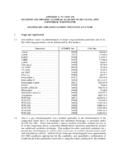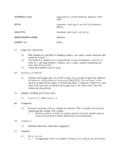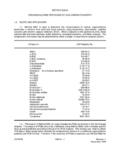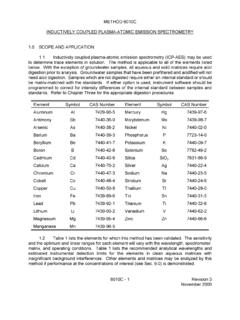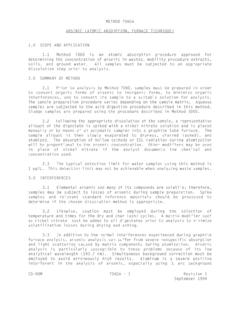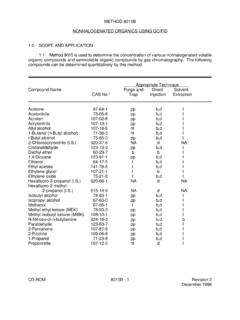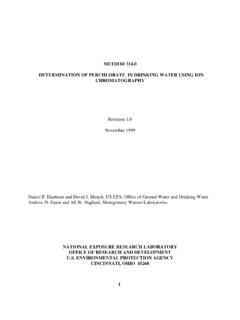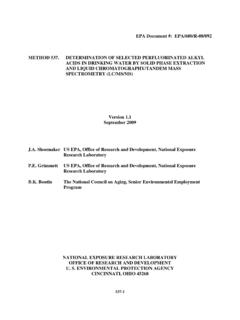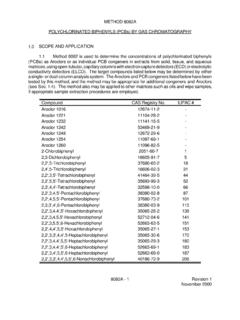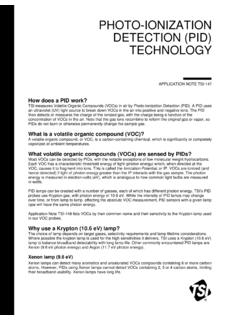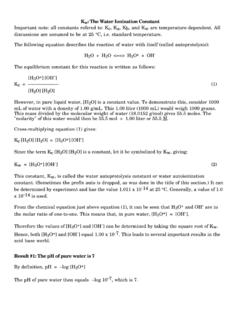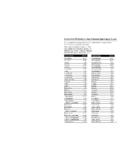Transcription of APPENDIX A TO PART 136 METHODS FOR …
1 APPENDIX A TO PART 136 METHODS FOR ORGANIC CHEMICAL ANALYSIS OF MUNICIPAL ANDINDUSTRIAL WASTEWATERMETHOD 625 BASE/NEUTRALS AND and method covers the determination of a number of organic compounds that arepartitioned into an organic solvent and are amenable to gas chromatography. Theparameters listed in Tables 1 and 2 may be qualitatively and quantitativelydetermined using this method may be extended to include the parameters listed in Table 3. Benzidinecan be subject to oxidative losses during solvent concentration. Under the alkalineconditions of the extraction step, "-BHC, (-BHC, endosulfan I and II, and endrin aresubject to decomposition. Hexachlorocyclopentadiene is subject to thermaldecomposition in the inlet of the gas chromatograph, chemical reaction in acetonesolution, and photochemical decomposition.)
2 N-nitrosodimethylamine is difficult toseparate from the solvent under the chromatographic conditions described. N-nitrosodiphenylamine decomposes in the gas chromatographic inlet and cannot beseparated from diphenylamine. The preferred method for each of these parameters islisted in Table is a gas chromatographic/mass spectrometry (GC/MS) method applicable to2,14the determination of the compounds listed in Tables 1, 2, and 3 in municipal andindustrial discharges as provided under 40 CFR Part method detection limit (MDL, defined in Section ) for each parameter is1listed in Tables 4 and 5. The MDL for a specific wastewater may differ from thoselisted, depending upon the nature of interferences in the sample modification to this method, beyond those expressly permitted, shall beconsidered as a major modification subject to application and approval of alternatetest procedures under 40 CFR Parts and Depending upon the nature ofthe modification and the extent of intended use, the applicant may be required todemonstrate that the modifications will produce equivalent results when applied torelevant method is restricted to use by or under the supervision of analysts experiencedin the use of a gas chromatograph/mass spectrometer and in the interpretation ofmass spectra.
3 Each analyst must demonstrate the ability to generate acceptable resultswith this method using the procedure described in Section of measured volume of sample, approximately 1 L, is serially extracted withmethylene chloride at a pH greater than 11 and again at a pH less than 2 using aseparatory funnel or a continuous extractor. The methylene chloride extract is dried,2concentrated to a volume of 1 mL, and analyzed by GC/MS. Qualitativeidentification of the parameters in the extract is performed using the retention timeand the relative abundance of three characteristic masses (m/z). Quantitative analysisis performed using internal standard techniques with a single characteristic interferences may be caused by contaminants in solvents, reagents, glassware,and other sample processing hardware that lead to discrete artifacts and/or elevatedbaselines in the total ion current profiles.
4 All of these materials must be routinelydemonstrated to be free from interferences under the conditions of the analysis byrunning laboratory reagent blanks as described in Section must be scrupulously cleaned. Clean all glassware as soon as3possible after use by rinsing with the last solvent used in it. Solvent rinsingshould be followed by detergent washing with hot water, and rinses with tapwater and distilled water. The glassware should then be drained dry, andheated in a muffle furnace at 400 C for 15-30 minutes. Some thermally stablematerials, such as PCBs, may not be eliminated by this treatment. Solventrinses with acetone and pesticide quality hexane may be substituted for themuffle furnace heating. Thorough rinsing with such solvents usuallyeliminates PCB interference.
5 Volumetric ware should not be heated in a mufflefurnace. After drying and cooling, glassware should be sealed and stored in aclean environment to prevent any accumulation of dust or other inverted or capped with aluminum use of high purity reagents and solvents helps to minimize interferenceproblems. Purification of solvents by distillation in all-glass systems may interferences may be caused by contaminants that are co-extracted from thesample. The extent of matrix interferences will vary considerably from source tosource, depending upon the nature and diversity of the industrial complex ormunicipality being base-neutral extraction may cause significantly reduced recovery of phenol,2-methylphenol, and 2,4-dimethylphenol. The analyst must recognize that resultsobtained under these conditions are minimum packed gas chromatographic columns recommended for the basic fraction maynot exhibit sufficient resolution for certain isomeric pairs including the following:anthracene and phenanthrene; chrysene and benzo(a)anthracene; andbenzo(b)fluoranthene and benzo(k)fluoranthene.
6 The gas chromatographic retentiontime and mass spectra for these pairs of compounds are not sufficiently different tomake an unambiguous identification. Alternative techniques should be used toidentify and quantify these specific compounds, such as Method samples that contain an inordinate number of interferences, the use of chemicalionization (CI) mass spectrometry may make identification easier. Tables 6 and 7 givecharacteristic CI ions for most of the compounds covered by this method. The use ofCI mass spectrometry to support electron ionization (EI) mass spectrometry isencouraged but not toxicity or carcinogenicity of each reagent used in this method have not beenprecisely defined; however, each chemical compound should be treated as a potentialhealth hazard.
7 From this viewpoint, exposure to these chemicals must be reduced tothe lowest possible level by whatever means available. The laboratory is responsiblefor maintaining a current awareness file of OSHA regulations regarding the safehandling of the chemicals specified in this method. A reference file of material datahandling sheets should also be made available to all personnel involved in thechemical analysis. Additional references to laboratory safety are available and havebeen identified for the information of the following parameters covered by this method have been tentatively classified asknown or suspected, human or mammalian carcinogens: benzo(a)anthracene,benzidine, 3,3 -dichlorobenzidine, benzo(a)pyrene, "-BHC, $-BHC, *-BHC, (-BHC,dibenzo(a,h)anthracene, N-nitrosodimethylamine, 4,4 -DDT, and polychlorinatedbiphenyls (PCBs).)
8 Primary standards of these toxic compounds should be prepared ina hood. A NIOSH/MESA approved toxic gas respirator should be worn when theanalyst handles high concentrations of these toxic and equipment, for discrete or composit sample bottle 1 L or 1 qt, amber glass, fitted with a screw cap linedwith Teflon. Foil may be substituted for Teflon if the sample is not amber bottles are not available, protect samples from light. The bottle andcap liner must be washed, rinsed with acetone or methylene chloride, anddried before use to minimize sampler (optional) The sampler must incorporate glass samplecontainers for the collection of a minimum of 250 mL of sample. Samplecontainers must be kept refrigerated at 4 C and protected from light duringcompositing.
9 If the sampler uses a peristaltic pump, a minimum length ofcompressible silicone rubber tubing may be used. Before use, however, thecompressible tubing should be throughly rinsed with methanol, followed byrepeated rinsings with distilled water to minimize the potential forcontamination of the sample. An integrating flow meter is required to collectflow proportional (All specifications are suggested. Catalog numbers are included forillustration only.) funnel 2 L, with Teflon column Chromatographic column, 19 mm ID, with coarse tube, Kuderna-Danish 10 mL, graduated (Kontes K-570050-1025or equivalent). Calibration must be checked at the volumes employed in thetest. Ground glass stopper is used to prevent evaporation of flask, Kuderna-Danish 500 mL (Kontes K-57001-0500 orequivalent).
10 Attach to concentrator tube with column, Kuderna-Danish Three all macro (Kontes K-503000-0121 orequivalent). column, Kuderna-Danish Two-ball macro (Kontes K-569001-0219 orequivalent). 10-15 mL, amber glass, with Teflon-lined screw liquid-liquid extractor Equipped with Teflon or glass connectingjoints and stopcocks requiring no lubrication. (Hershberg-Wolf Extractor, AceGlass Company, Vineland, , P/N 6841-10 or equivalent.) chips Approximately 10/40 mesh. Heat to 400 C for 30 minutes of Soxhletextract with methylene bath Heated, with concentric ring cover, capable of temperature control( 2 C). The bath should be used in a Analytical, capable of accurately weighing Chromatograph An analytical system complete with a temperatureprogrammable gas chromatograph and all required accessories includingsyringes, analytical columns, and gases.
